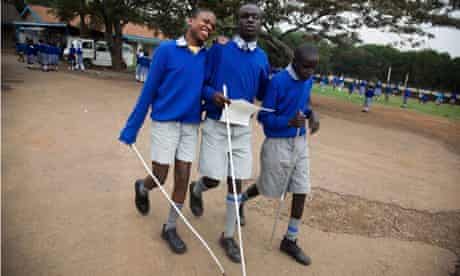What is deafblindness?
Deafblindness is a combination of sight and hearing loss that affects a person’s ability to communicate, access information and get around.It’s also sometimes called “dual sensory loss” or “multi-sensory impairment”.A deafblind person won’t usually be totally deaf and totally blind, but both senses will be reduced enough to cause significant difficulties in everyday life.These problems can occur even if hearing loss and vision loss are mild, as the two senses work together and one would usually help compensate for loss of the other.
Signs of deafblindness
Deafblindness most commonly affects older adults, although it can affect people of all ages, including babies and young children.
In older people, it may develop gradually and the person themselves may not realise their vision and/or hearing is getting worse at first.
Signs and symptoms of deafblindness
A person who’s deafblind won’t usually be totally deaf and totally blind, but both senses will be reduced enough to cause difficulties with everyday activities.
The hearing and/or vision problems may be present from birth, but in many cases one or both problems develop gradually as a person gets older and they may not notice it themselves at first.
If someone you know has a combination of the signs mentioned below, it’s possible they have some degree of deafblindness and should seek medical advice.
Signs of a hearing problem
Hearing loss can occur from birth or may develop gradually or suddenly later on.
Signs that someone may have a problem with their hearing include:
- not hearing you if you speak to them from behind
- needing to turn up the volume on the television or radio
- difficulty following a conversation – particularly if several people are speaking or the person they’re speaking to is unfamiliar
- not hearing noises around them, such as a knock at the door or the doorbell ringing
- asking others to speak loudly, slowly and more clearly
- leaning in very close to hear what’s being said.
If someone already has a hearing problem – for example, they wear a hearing aid or use sign language – keep an eye out for signs of vision problems that could develop.
Signs of a vision problem
Vision loss can also be present from birth or develop later on.
Signs that someone may have a problem with their vision include:
- problems seeing in low light or bright light
- difficulty recognising people they know
- finding it hard to read facial expressions
- relying on touch to find and identify items more than usual
- needing to hold books or newspapers close to their face, or sitting near the television
- difficulty moving around unfamiliar places – they may bump into or trip over things regularly
- not looking directly at you or making proper eye contact.
If a person already has a problem with their vision – for example, they wear glasses, use a cane to get around, or have a condition such as glaucoma or cataracts – keep an eye out for signs of hearing problems that could develop.
Causes of deafblindness
There are many possible causes of deafblindness. The condition can either be present at birth or develop later in life.
Deafblindness from birth
Deafblindness from birth is known as congenital deafblindness.
It can be caused by:
- problems associated with premature birth (birth before 37 weeks of pregnancy)
- an infection picked up during pregnancy, such as rubella (German measles), toxoplasmosis or cytomegalovirus (CMV)
- genetic conditions, such as CHARGE syndrome or Down’s syndrome
- cerebral palsy – a problem with the brain and nervous system that mainly affects movement and co-ordination
- foetal alcohol syndrome – health problems caused by drinking alcohol in pregnancy.
Deafblindness later in life
In most cases, deafblindness develops later in life. This is known as acquired deafblindness.
A person with acquired deafblindness may be born without a hearing or sight problem and then later loses part or all of both senses.
Alternatively, someone may be born with either a hearing or vision problem, and then later loses part or all of the other sense later on.
Problems that can contribute to acquired deafblindness include:
- age-related hearing loss
- Usher syndrome – a genetic condition that affects hearing, vision and balance
- eye problems associated with increasing age, such as age-related macular degeneration (AMD), cataracts and glaucoma
- diabetic retinopathy – a complication of diabetes where the cells lining the back of the eye are damaged by high blood sugar levels
- damage to the brain, such as from meningitis, encephalitis, a stroke or severe head injury.
Living with deafblindness
A range of care and support services is available to help deafblind people.
Each deafblind person will have a different level of hearing and sight loss, which means they’ll have their own individual care needs.
The general aims of care for a deafblind person are to:
- preserve and maximise any remaining sight or hearing the person has – this could involve treating underlying conditions like cataracts, wearing glasses or using a hearing aid
- teach alternative methods of communication – such as hand on hand signing or braille
- help retain or develop as much independence as possible – for example, by training the person to use a long cane, a guide dog or offering a communicator guide.
Your local authority should arrange an assessment to determine exactly what care and support is needed.


